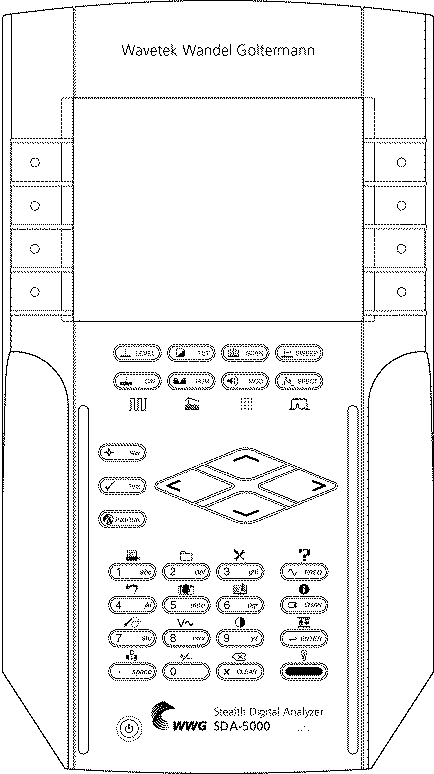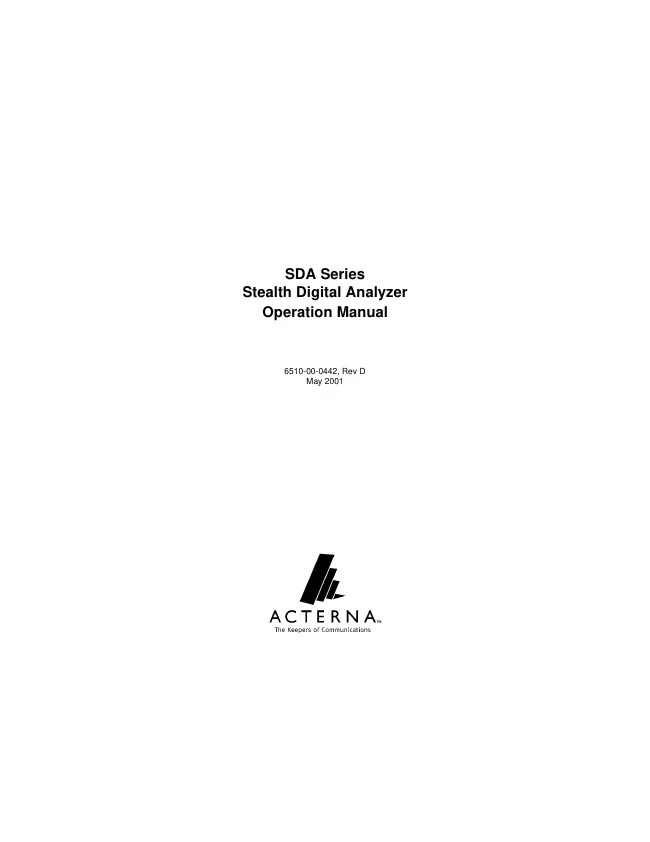Acterna - SDA-5500 - Analyzer
Manufacturer:

Image 1 of 1
If you have any other photos or manuals for the
Acterna SDA-5500
you can
upload the files here.
Equipment:
SDA-5500
Date:
2001
Category:
Group:
Sub Group:
Information
The Stealth Digital Analyzer (SDA) cable network measurement
tools test a wide range of critical parameters, helping you
prove and maintain your system’s performance. Advanced
features include tools to support preventative maintenance
programs for improving network quality.
Applications include aligning amplifiers such as optical
nodes, testing the performance of both forward and reverse
path networks, finding and fixing sources of reverse path
ingress, measuring signal quality (both continuous and
bursty digital carriers), and fulfilling FCC and CENELEC
proof-of-performance requirements.
You can perform comprehensive troubleshooting and
preventative maintenance tests with accuracy and ease using
Acterna’s SDA products:
• Quickly check frequency response, signal levels, hum,
carrier-to-noise (C/N) ratio, depth of modulation, and
monitor the general performance of the cable system
• Perform tests without interfering with CATV subscribers'
service
• Evaluate system performance precisely and diagnose and
eliminate problems quickly to maintain quality operation of
your CATV system equipment.
Acterna’s Stealth Sweep System consists of at least two
major components:
a headend transmitter and a field receiver.
SDA-5500 Stealth Sweep Transceiver
The SDA-5500 is a standard 19" rack mount unit weighing
approximately fifteen pounds. Its 320 X 240 dot matrix LCD
shows measurement data in both graphical and numerical form.
It is a full-featured signal analysis meter with a complete
spectrum display and an analog representation of single
channel measurement data. When tuned to a specific channel,
a comprehensive set of information is provided, including:
• tuned channel
• video frequency and level
• audio frequency and level
• differences between video and audio carrier levels
The SDA-5500 performs essential cable TV system preventive
maintenance tests with accuracy and ease. Signal levels,
hum, C/N, and, in tandem with the SDA-5000, frequency
response, can be quickly tested without interfering
with subscribers’ service.
The Sweep System is made up of two components: the field
unit (SDA- 5000), and one or both of the headend units
(SDA-5500 and SDA-5510).
Sweep response is tested by injecting a low-level signal in
vacant spectrum areas and by monitoring cable system carrier
levels in occupied spectrum areas. In addition to generating
the sweep test signal, the SDA-5500 continuously monitors
the system carriers. It sends headend level readings
to the field receiver with every sweep update. In this way,
any headend level changes are compensated for by the
receiver, maintaining measurement accuracy.
Sweep response measurements won’t be affected by changing
signal levels in the headend. The SDA-5500 has the
measurement capability of the SDA-5000 so you can keep an
eye on headend levels.
With the Reverse Sweep option (OPT2), a transmitter is built
into the hand-held sweep receiver. The headend sweep
transmitter (SDA-5500) is set up to receive the reverse
sweep sent from the field. When a reverse sweep is
activated from a field test point, the headend transmitter
receives the telemetry signal indicating which receiver is
sending the sweep. The headend transmitter measures the
sweep and sends the results to the field via its telemetry
signal. The field receiver with the tagged serial number
then displays the sweep response as measured in the headend.
1 Manual
User manual
Manual type:
User manual
Pages:
410
Size:
9.2 MB
Language:
english
Revision:
D
Manual-ID:
6510-00-0442
Date:
May 2001
Quality:
Electronic document, no scan, very well readable.
Upload date:
Aug. 16, 2018
MD5:
b0a73323-7ca2-38f1-7e71-7ac62136a3ec
Downloads:
1465
